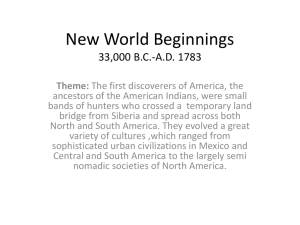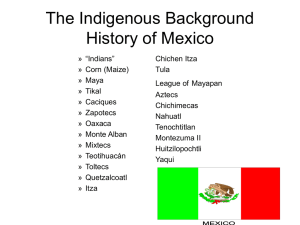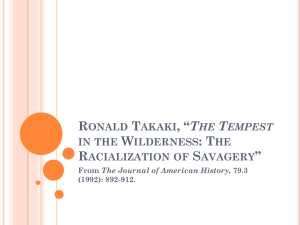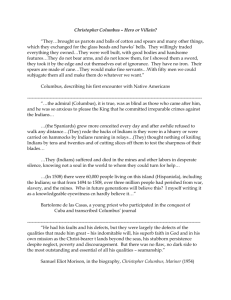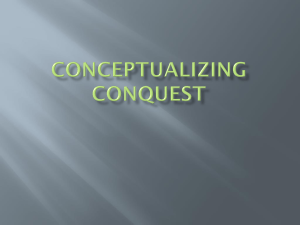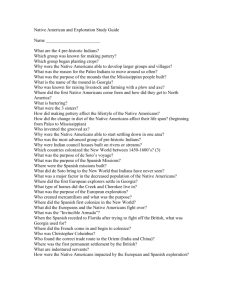Chapter_1
advertisement
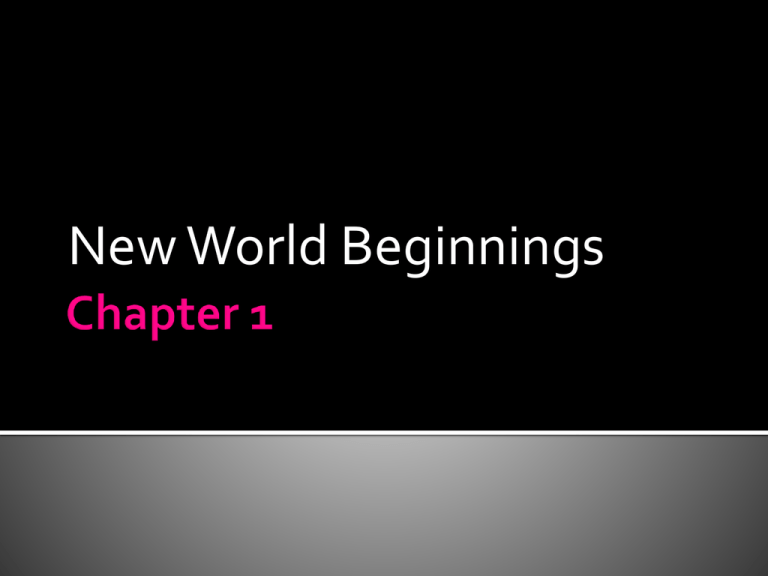
New World Beginnings For chapter 1 &2 some of you have already started taking Cornell notes. As I lecture continue and add on. Also, by now you should have emailed me your results for chapter 1&2. Answer the following questions in your notes. Put the question on the left hand side and the answer on the right. 1. What obstacles do you think the people in the ice age encounter? 2. How do we know the ice age existed? 3. How did people share ideas and resources in the Americas? After reading the article about the ice age, write down 1 interesting thought you have about the ice age. Recorded history began 6,000 years ago. It was 500 years ago that Europeans set foot on the Americas to begin colonization Theory of Pangaea: continents once one large land mass then broke apart Huge sheets of ice, or glaciers, covered large portions of its continents. Continuous cycle. likely that the earth will experience another glacial advance, perhaps in the next 10,000 to 20,000 years, and that the glacial/interglacial cycles will continue. Geologic history shows, however, that ice ages eventually come to a complete end and do not occur again for several hundred million years. The Land Bridge theory. As the Great Ice Age diminished, so did the glaciers over North America. The theory holds that a Land Bridge emerged linking Asia & North America across what is now known as the Bering Sea. Those people eventually populated N. & S. America. Some venture to warmer climates: Incas, Mayas, and Aztecs Caribbean Amerindian Arawak Indians, the name given by Spanish explorers to several tribes who spoke related languages. They were peaceful, agricultural people. At one time they were widely distributed from the Florida Keys to Argentina, but by the time of the European discovery of the Americas in the 15th century, they had been driven from many areas by other tribes. Today, tribes speaking Arawak languages can be found in northeastern South America. CITY OF RUINS NATIVE CLOTHING All that I saw were young men, none of them more than thirty years old, very well made, of very handsome bodies and very good faces; the hair was coarse almost as teh hair of a horse's tail and short; the hair they wear over their eyebrows, except for a hank behind that they wear long and never cut. Some of them paint themselves black (and they are the color of the Canary Islanders, neither black or white), and some paint themselves white, and others red and others with what they have. Some paint their faces, others the whole body, others the eyes only, others only the nose. They bear no arms, nor know thereof; for I showed them swords and they grasped them by the blade and cut themselves through ignorance; they have no iron. Their darts are a kind of rod without iron, and some have at the end a fish's tooth and others, other things…. They are generally fairly tall and good looking, well made. I saw some who had marks of wounds on their bodies, and made signs to ask them what it was, and they showed me how people of other islands which are near came there and wished to capture them, and they defended themselves. And I believed and now believe that people do come here from teh mainland to take them as slaves. They ought to be good servants and of good skill, for I see that they repeat very quickly all that is said to them; and I believe that they would easily be made Christians, because it seems to me that they belonged to no religion. PYRAMID LOCATION AZTEC WARRIOR TENOCHTITLAN Development of corn or maize around 5,000 B.C. in Mexico helped people settled down, stop them from mainly being hunters and gatherers society which resulted in the rise of cities and town Corn arrive in America 1,200 B.C. Grown by Pueblo Indians who lived in Adobe houses. Had irrigation Built huge ceremonial and burial mounds and were located in the Ohio Valley. Cahokia, near East St. Louis today, held 40,000 people. One mound, located across the Mississippi River from St. Louis, is larger than the Great Pyramid in Egypt. Its base covered 14 acres and it rose in four terraces to 100 feet. Grew corn, beans, and squash This group likely had the best (most diverse) diet of all North American Indians and is typified by the Cherokee, Creek, Choctaw (South) and Iroquois (North). Hiawatha leader of the group. The Iroquois Confederation was a group of 5 tribes in New York state (later 6): Mohawk, Oneida, Onondaga, Cayuga, and Seneca. Tuscarora . Meet together to discuss concerns Matrilineal society: authority property passed down through female Believed land is not own individual but by tribe Believed nature sacred Little interest in money Norse (Viking from Norway) here 1st: Erik the Red and Leif Erikson. Landed in Newfoundland. No written record (just songs and sagas) so they didn’t get credit Marco Polo traveled to China and stirred up a storm of European interest. Desire for goods increases trade and exploration New developments helped travel: 1. Caravel: fast ship 2. compass: determine direction 3. astrolabe: a sextant gizmo that could tell a ship's latitude. COMPASS ASTROLABE Faster, get to destination Popular explorers such as Bartolome Diaz, Vasco da Gama, and Christopher Columbus relied on the caravel in their many sojourns into the unknown. 1st slave trade was across the Sahara Desert. Then the West African coast. Family broken apart as a control method Christopher Columbus convinced Isabella and Ferdinand to fund his expedition. They wanted to become a powerhouse in the world. Wanted to find new route to India, thought he made it when he landed in Hispaniola (modern day Bahamas). Called natives Indians (Arawak) By the time Columbus arrived in the west, the island Arawaks were divided into several groups. In the west, the Lucayanos occupied the Bahamas, the Borequinos were in Puerto Rico and the Tainos lived in Cuba, Jamaica and Haiti. Note that "taino" is an Arawak word meaning peace. Barbados and Trinidad in the east was settled by the Ignerian Arawaks. Even though Columbus did not technically discover America, his voyage set off a race by different countries to explore the world Europe would provide the market, capital, technology. Africa would provide the labor. The New World would provide the raw materials (gold, soil, lumber). Columbian Exchange: From the New World (America) to the Old ▪ corn, potatoes, tobacco, beans, peppers, manioc, pumpkin, squash, tomato, wild rice, etc. ▪ also, syphilis From the Old World to the New ▪ cows, pigs, horses, wheat, sugar cane, apples, cabbage, citrus, carrots, Kentucky bluegrass, etc. ▪ devastating diseases (smallpox, yellow fever, malaria), as Indians had no immunities. ▪ The Indians had no immunities in their systems built up over generations. ▪ An estimated 90% of all pre-Columbus Indians died, mostly due to disease. Treaty Line of Tordesillas 1494: Portugal and Spain feuded over who got what land. The Pope drew this line as he was respected by both. The line ran North-South, and chopped off the Brazilian coast of South America Portugal got everything east of the line (Brazil and land around/under Africa) Spain got everything west of the line (which turned out to be much more, though they didn't know it at the time) Vasco Balboa: "discovered"•the Pacific Ocean across isthmus of Panama Ferdinand Magellan: circumnavigates the globe (1st to do so) Ponce de Leon: touches and names Florida looking for legendary Fountain of Youth Hernando Cortes: enters Florida, travels up into present day Southeastern U.S., dies and is "buried"•in Mississippi River Francisco Pizarro: conquers Incan Empire of Peru and begins shipping tons of gold/silver back to Spain. This huge influx of precious metals made European prices skyrocket (inflation). Francisco Coronado: ventured into current Southwest U.S. looking for legendary El Dorado, city of gold. He found the Pueblo Indians. Indians were "commended"•or given to Spanish landlords The idea of the encomienda was that Indians would work and be converted to Christianity, but it was basically just slavery on a sugar plantation guised as missionary work. Hernando Cortez conquered the Aztecs at Tenochtitlan. Cortez went from Cuba to present day Vera Cruz, then marched over mountains to the Aztec capital. Montezuma, Aztec king, thought Cortez might be the god Quetzalcoatl who was due to re-appear the very year. Montezuma welcomed Cortez into Tenochtitlan. The Spanish lust for gold led Montezuma to attack on the noche triste, sad night. Cortez and men fought their way out, but it was smallpox that eventually beat the Indians. The Spanish then destroyed Tenochtitlan, building the Spanish capital (Mexico City) exactly on top of the Aztec city. A new race of people emerged, mestizos, a mix of Spanish and Indian blood. Spanish society quickly spread through Peru and Mexico A threat came from neighbors: English: John Cabot (an Italian who sailed for England) touched the coast of the current day U.S. France: Giovanni de Verrazano also touched on the North American seaboard. France: Jacques Cartier went into mouth of St. Lawrence River (Canada). To oppose this, Spain set up forts (presidios) all over the California coast. Also cities, like St. Augustine in Florida. Eventually Spain would be confined to the southern region, did not go further than Florida and New Mexico Don Juan de Onate: took over NM brutally, cut off one feet of Native to remind them of servitude Robert de LaSalle sailed down the Mississippi River for France claiming the whole region for their King Louis and naming the area "Louisiana" after his king Black Legend: The Black Legend was the notion that Spaniards only brought bad things (murder, disease, slavery); though true, they also brought good things such as law systems, architecture, Christianity, language, civilization, so that the Black Legend is partly, but not entirely, accurate.
